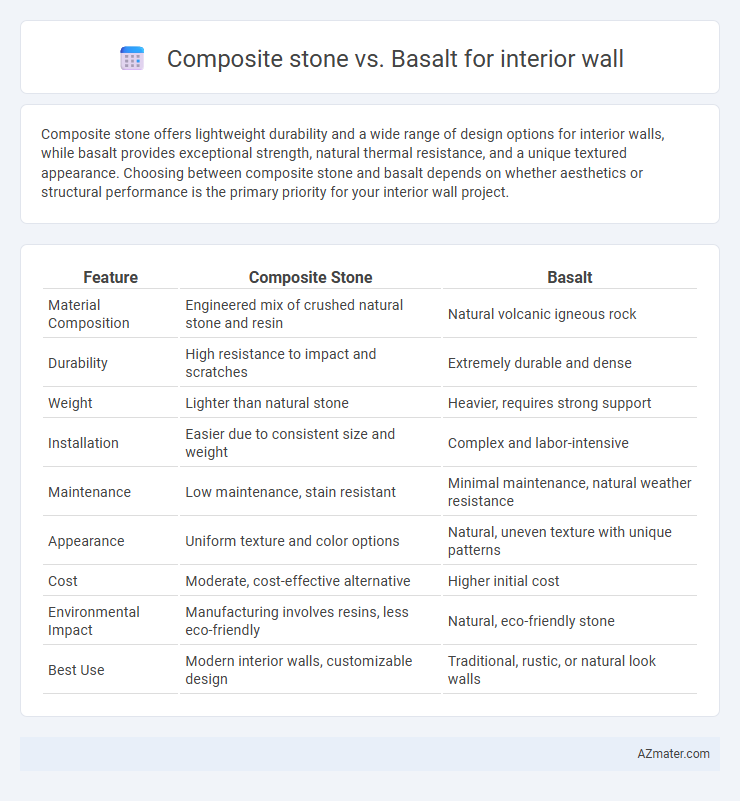Composite stone offers lightweight durability and a wide range of design options for interior walls, while basalt provides exceptional strength, natural thermal resistance, and a unique textured appearance. Choosing between composite stone and basalt depends on whether aesthetics or structural performance is the primary priority for your interior wall project.
Table of Comparison
| Feature | Composite Stone | Basalt |
|---|---|---|
| Material Composition | Engineered mix of crushed natural stone and resin | Natural volcanic igneous rock |
| Durability | High resistance to impact and scratches | Extremely durable and dense |
| Weight | Lighter than natural stone | Heavier, requires strong support |
| Installation | Easier due to consistent size and weight | Complex and labor-intensive |
| Maintenance | Low maintenance, stain resistant | Minimal maintenance, natural weather resistance |
| Appearance | Uniform texture and color options | Natural, uneven texture with unique patterns |
| Cost | Moderate, cost-effective alternative | Higher initial cost |
| Environmental Impact | Manufacturing involves resins, less eco-friendly | Natural, eco-friendly stone |
| Best Use | Modern interior walls, customizable design | Traditional, rustic, or natural look walls |
Introduction to Composite Stone and Basalt
Composite stone, engineered from a blend of natural stone fragments and resin binders, offers versatility, durability, and a uniform appearance ideal for interior walls. Basalt, a dense volcanic igneous rock, is prized for its strength, dark color, and natural texture, providing a unique aesthetic and long-lasting performance. Both materials serve as excellent options for interior wall cladding, combining functional and decorative benefits.
Material Composition and Manufacturing Process
Composite stone for interior walls typically consists of crushed natural stone bound with resins or cement, creating a lightweight yet durable material with customizable textures and colors. Basalt, a volcanic igneous rock, is naturally dense and formed through the rapid cooling of lava, providing exceptional hardness and resistance without the addition of binders. The manufacturing process of composite stone involves molding and curing mixtures to achieve uniformity and design flexibility, while basalt is quarried and cut into slabs, emphasizing natural patterns and strength.
Aesthetic Appeal and Design Versatility
Composite stone offers a wide range of colors and textures, allowing for customizable aesthetic appeal that can mimic natural stone or incorporate unique patterns, ideal for modern and eclectic interior wall designs. Basalt provides a sleek, dark, and uniform appearance with a natural matte finish that enhances minimalist and industrial interiors, delivering timeless elegance and subtle sophistication. Design versatility favors composite stone for its adaptability across diverse styles, while basalt excels in creating striking visual contrasts and durable, low-maintenance surfaces.
Strength and Durability Comparison
Composite stone offers moderate strength and durability, benefiting from engineered resins that enhance resistance to impact and staining, making it suitable for interior walls with light to medium use. Basalt, a natural volcanic rock, exhibits exceptional hardness and high compressive strength, providing superior durability and longevity for interior wall applications subject to heavy wear or potential damage. Basalt resists scratches, weathering, and chemical exposure better than composite stone, ensuring a longer-lasting, low-maintenance surface in demanding interior environments.
Installation Methods and Complexity
Composite stone offers easier installation for interior walls due to its lightweight nature and uniform sizes, allowing for quicker handling and adherence with standard adhesives. Basalt, being heavier and denser, requires more specialized anchoring techniques and skilled labor to ensure proper alignment and secure attachment. The complexity of basalt installation often leads to longer project timelines and higher labor costs compared to composite stone.
Maintenance Requirements and Longevity
Composite stone offers low maintenance with its non-porous surface resisting stains and scratches, making it ideal for busy interiors, while basalt, a natural volcanic rock, requires periodic sealing to prevent moisture absorption and preserve its appearance. Basalt boasts superior longevity due to its natural hardness and resistance to weathering, often lasting decades without significant degradation. Composite stone typically provides consistent durability but may show wear over time under heavy use compared to the long-term robustness of basalt.
Cost Analysis: Composite Stone vs Basalt
Composite stone offers a more cost-effective option for interior walls with prices typically ranging from $20 to $50 per square foot, compared to basalt, which averages between $30 and $70 per square foot due to its natural stone extraction and processing expenses. Installation costs for composite stone are generally lower because of its lighter weight and easier cutting properties, reducing labor time and overall project budget. Maintenance expenses also favor composite stone, as it resists staining and requires less sealing than basalt, which can incur higher upkeep costs over time.
Sustainability and Environmental Impact
Composite stone offers a sustainable option for interior walls by utilizing recycled materials and reducing the need for quarrying raw stone, which lowers environmental degradation. Basalt, a natural volcanic rock, is abundant and requires minimal processing, resulting in low embodied energy and excellent durability, contributing to its eco-friendly profile. Choosing either material depends on project priorities; composite stone excels in waste reduction, while basalt provides a natural, long-lasting option with minimal carbon footprint.
Popular Interior Wall Applications
Composite stone offers versatile design options and durability, making it ideal for feature walls, kitchen backsplashes, and bathroom surrounds in modern interiors. Basalt, known for its natural texture and strength, is frequently used in accent walls, fireplaces, and staircases, providing a sleek, contemporary look. Both materials enhance interior aesthetics with unique patterns and long-lasting surfaces suited for high-traffic residential and commercial spaces.
Choosing the Right Material for Your Space
Composite stone offers versatile design options, lightweight properties, and ease of installation, making it ideal for customizable, modern interior walls. Basalt provides superior durability, natural heat resistance, and a unique textured appearance, perfect for spaces requiring strength and a bold aesthetic. Selecting between composite stone and basalt depends on factors like desired texture, maintenance levels, and the wall's functional requirements within your interior environment.

Infographic: Composite stone vs Basalt for Interior Wall
 azmater.com
azmater.com